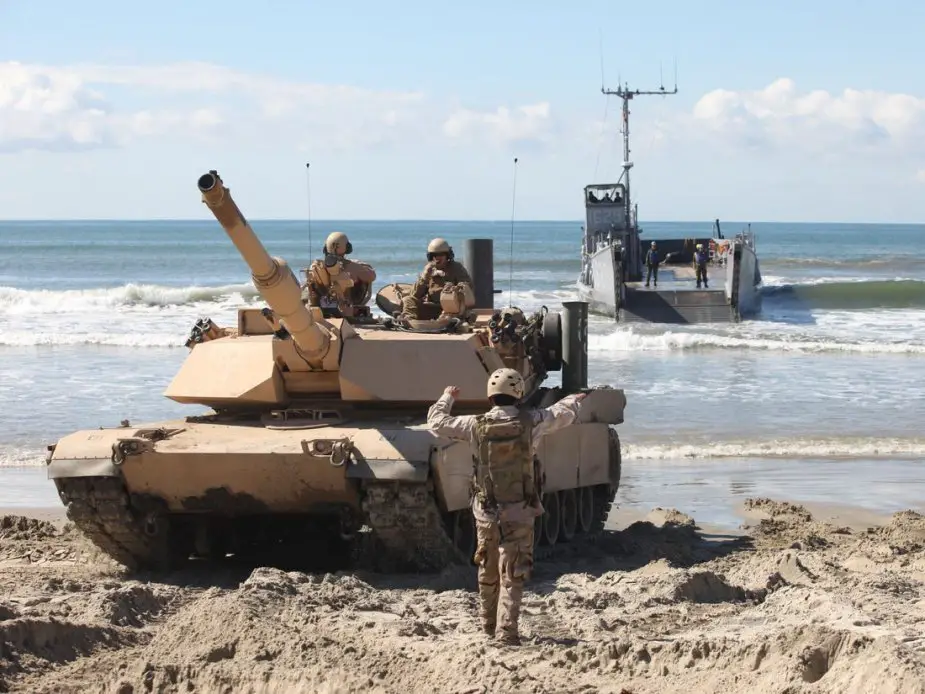U.S. Marine Corps to get rid of tanks, infantry battalions, howitzers, helicopters and more
In its restructuration program, the U.S. Marine Corps plans to cut tank battalions and reduce infantry units over the next 10 years while investing in new capabilities involving other equipment. “Developing a force that incorporates emerging technologies and a significant change to force structure within our current resource constraints will require the Marine Corps to become smaller and remove legacy capabilities,” the command said.

Opponents to the plan underline the necessity to keep enough high firepower for landings, which involves M1A1 Abrams main battle tanks (Picture source: USMC)
Since summer 2019, Yasmin Tadjdeh comments on National Defense, U.S. Marine Corps Commandant Gen. David Berger has been working to design a new USMC aiming at more efficiently compete with high-tech China and Russia, said a service announcement from Marine Corps Combat Development Command: “The Marine Corps is redesigning the 2030 force for naval expeditionary warfare in actively contested spaces, fully aligning the service with the direction of the" National Defense Strategy, it said. To prepare itself for naval expeditionary warfare in contested areas and adapt its means to Chinese or Russian units, the Marine Corps plans to get rid of law enforcement battalions, tank battalions and associated military occupational specialties, and all bridging companies by 2030, according to the announcement that was released March 23. Additionally, the service intends to reduce the number of infantry battalions from 24 to 21; artillery cannon batteries from 21 to 5; amphibious vehicle companies from 6 to 4; and cut tiltrotor (MV-22 Osprey), attack and heavy lift squadrons. The blueprint of the plan calls for a total force reduction of approximately 12,000 personnel over a 10-year period, a decline of slightly less than 7 percent relative to the current structure.
Infantry units in the future will be lighter, more versatile and have increased mobility to support naval expeditionary warfare and facilitate distributed and expeditionary advanced base operations, according to the press release issued by the USMC command.
The Marine Corps plans to deactivate Marine Medium Tiltrotor Squadron 264; Marine Heavy Helicopter Squadron 462; Marine Light Attack Helicopter Squadron 469; Marine Wing Support Groups 27 and 37; 8th Marine Regiment Headquarters Company; and 3rd Battalion, 8th Marines. It also intends to realign 1st Battalion, 8th Marines to 2nd Marines, and 2nd Battalion, 8th Marines to 6th Marines, while deactivating and relocating Marine Light Attack Helicopter Squadron 367 to Camp Pendleton, California. The Corps is canceling the activation of 5th Battalion, 10th Marines, but its assigned batteries will realign under the existing 10th Marine Regiment structure. The service expects to reduce the number of F-35B and F-35C primary aircraft authorized per squadron from 16 to 10, the announcement said.
“The future Fleet Marine Force requires a transformation from a legacy force to a modernized force with new organic capabilities,” the press release said. “The [Fleet Marine Force] in 2030 will allow the Navy and Marine Corps to restore the strategic initiative and to define the future of maritime conflict by capitalizing on new capabilities to deter conflict and dominate inside the enemy’s weapon engagement zone.”
The service wants to make investments in new systems to include longer-range precision fires, advanced reconnaissance capabilities, unmanned systems and resilient networks. For long-range precision fires, the service is planning for a 300 percent increase in rocket artillery capacity, which will be paired with anti-ship missiles, to enhance the Marine Corps' ability to support sea control and sea denial, the announcement said.
The service also aims to double the number of unmanned aerial system squadrons and "austere lethal" robotic air and ground systems: “Future budget requests will include an expanded list of viable unmanned capabilities that will create a significant opportunity for industries across the country,” the announcement noted.
Based on Berger’s planning guidance, the service intends to make III Marine Expeditionary Force the Marine Corps’ main focus, the announcement said. It envisions having three Marine Littoral Regiments organized, trained and equipped for sea denial and sea control. “This Pacific posture will be augmented by three globally deployable Marine Expeditionary Units that possess both traditional and expeditionary advanced base capabilities that can deploy with non-standard amphibious ready groups,” the announcement said. The service also hopes to increase maritime mobility and resilience through a new light amphibious warship and more affordable stern-landing and operational support vessels, according to the document.
The future force will also include mobile air-and-missile defense systems, the announcement said. Other capabilities on the wish list include directed energy systems; loitering munitions; signature management; electronic warfare; and expeditionary airfield capabilities and structure to support manned and unmanned aircraft and other systems from "austere, minimally developed locations."
Opponents to this plan underline the necessity to keep enough firepower for landings (which involves Abrams main battle tanks) and classic howitzers (including self-propelled ones), not only MLRS which need more time for reloading, and air defense. JLTVs with light automatic guns aren’t able to cross reefs and other difficult terrains like tracked vehicles can, hence the crucial need of developing the Amphibious Combat Vehicle program. High-tech equipment should not be the only focus in restructuring the U.S. Marine Corps.


























